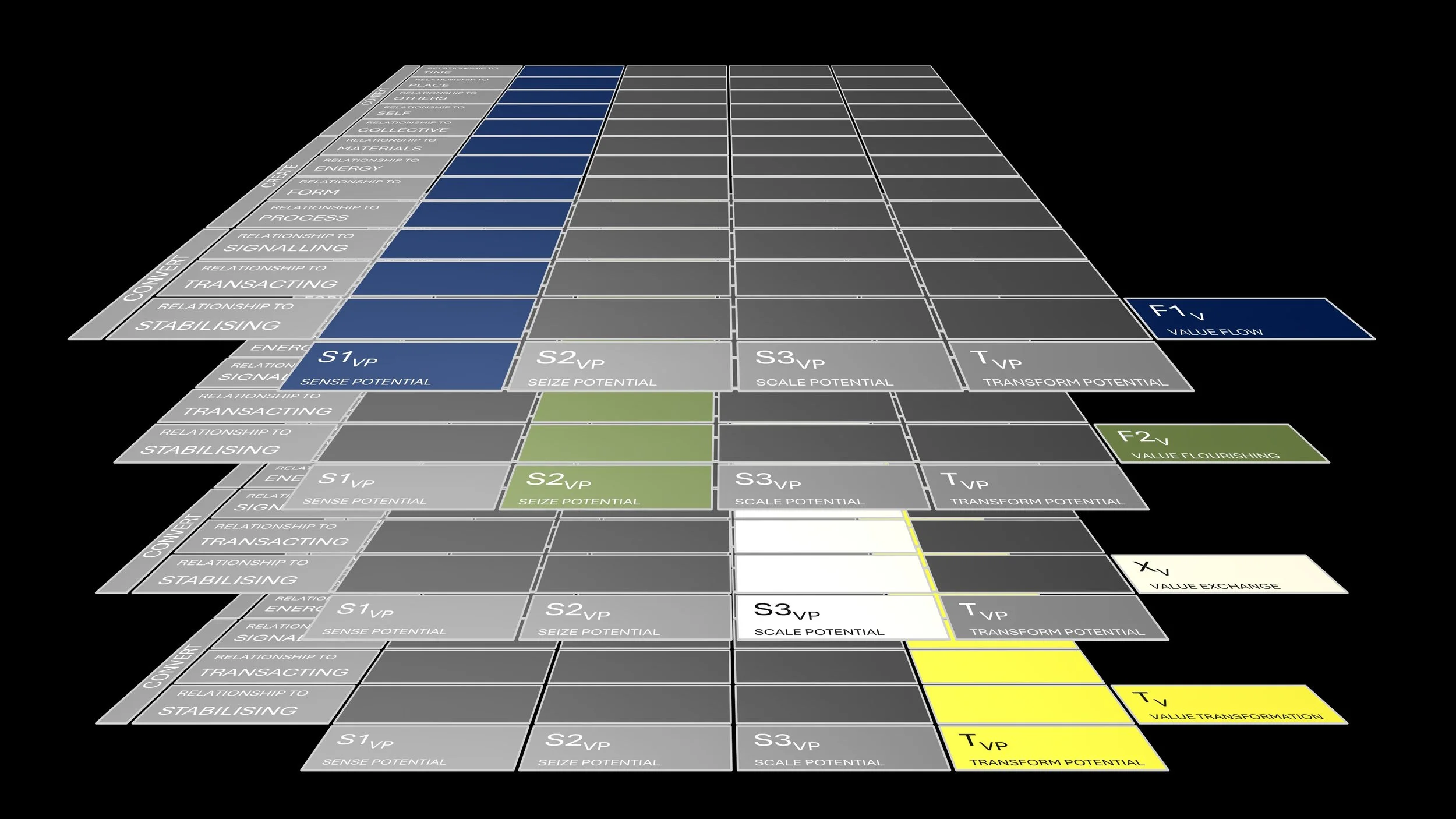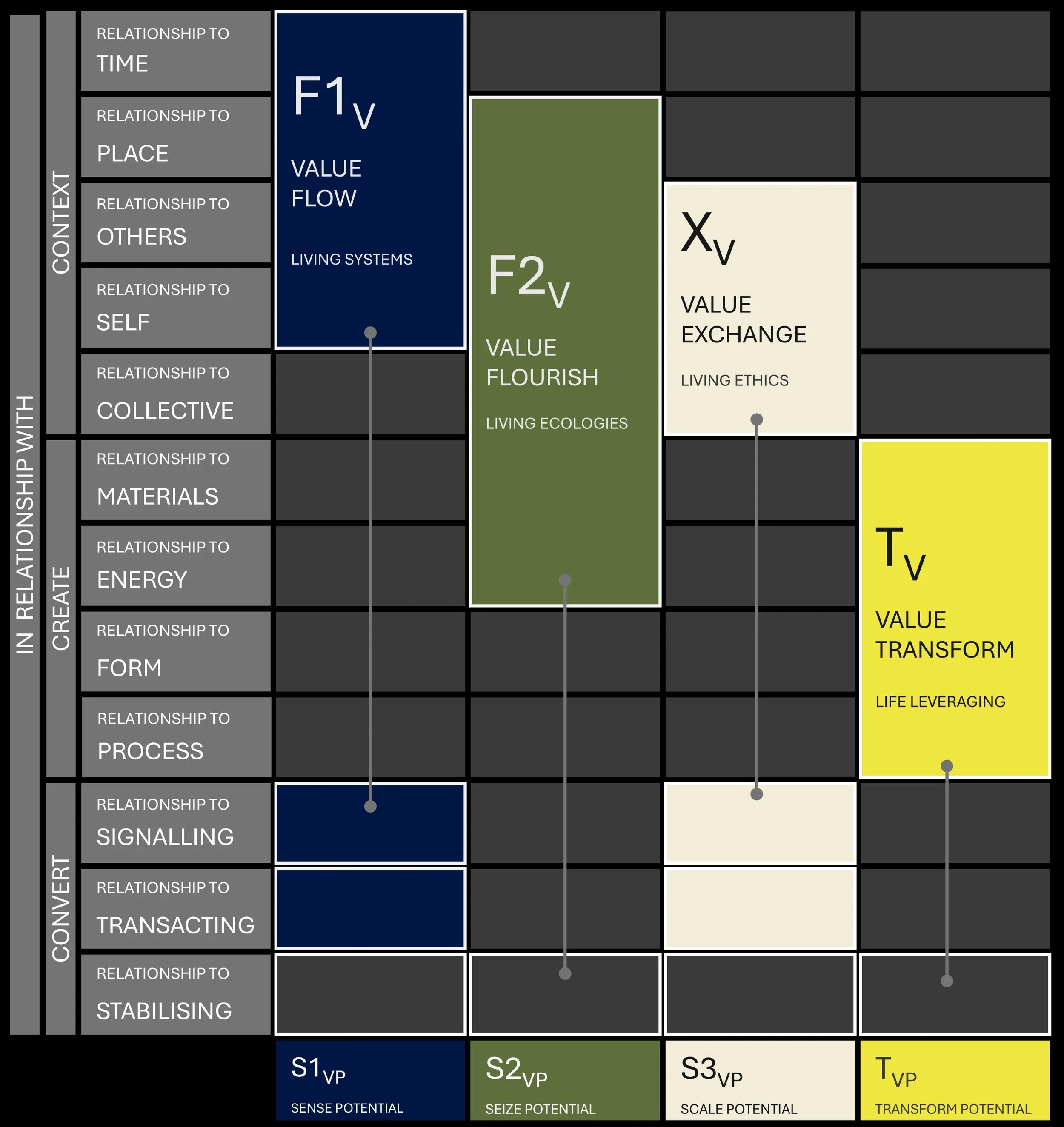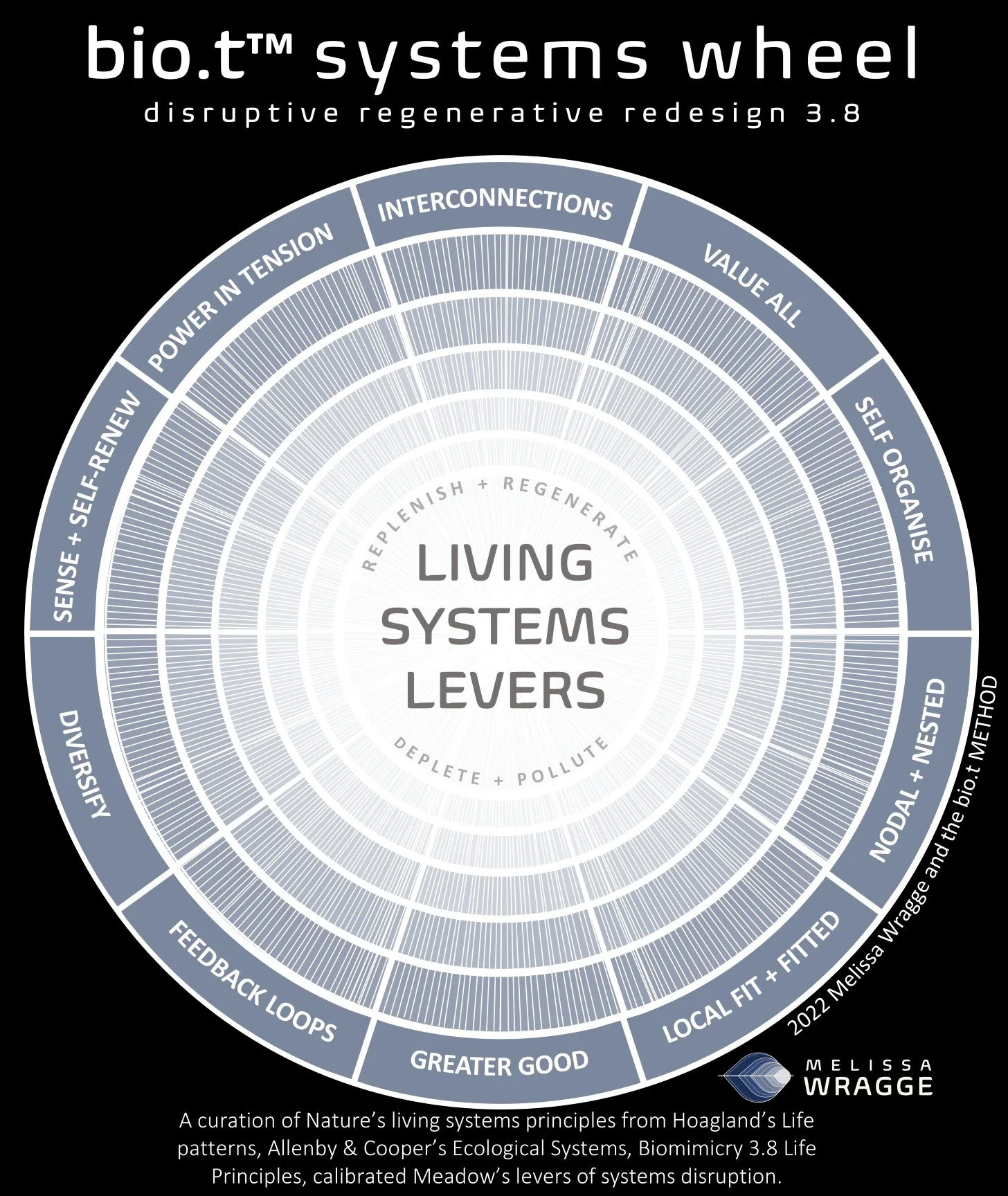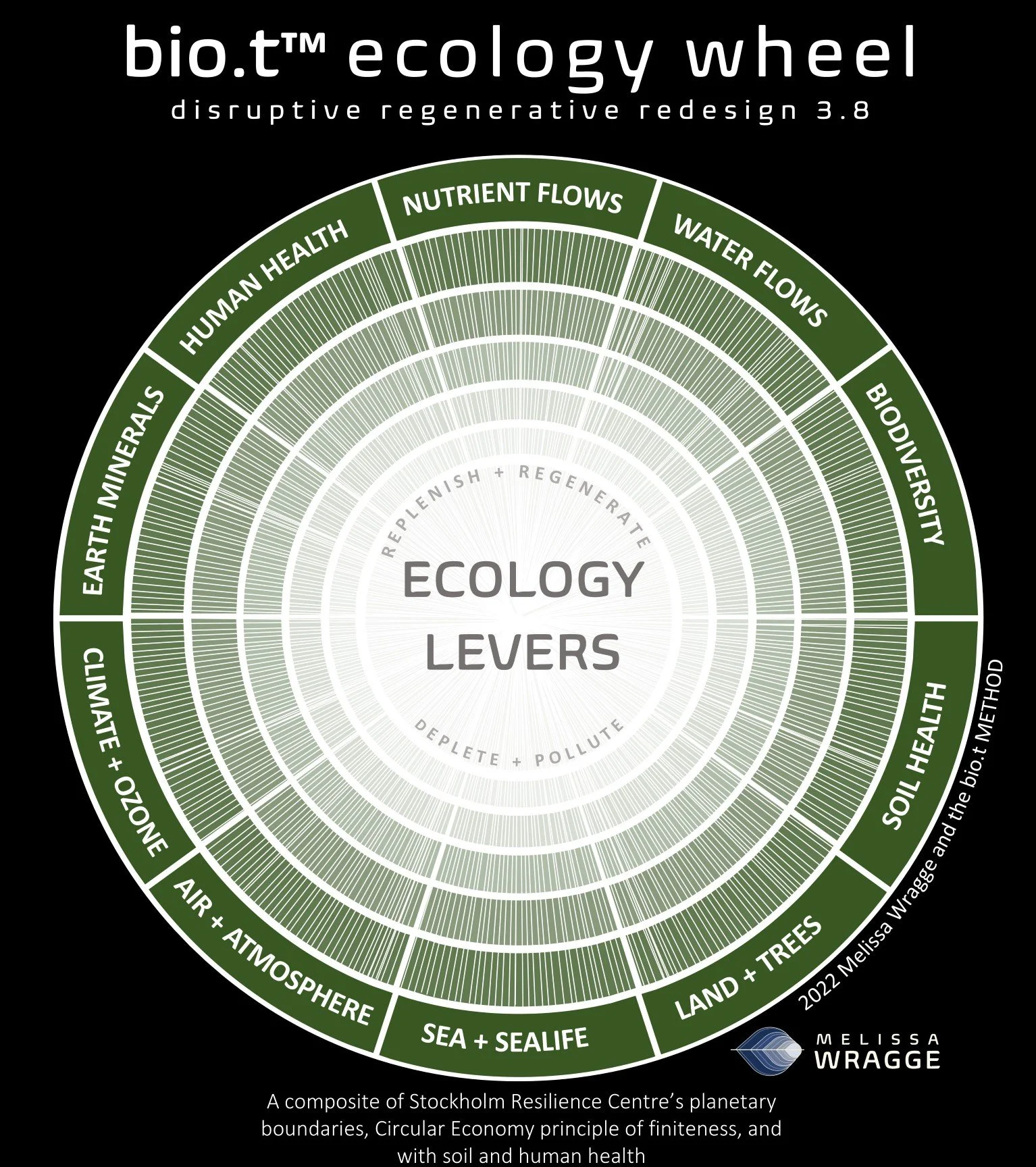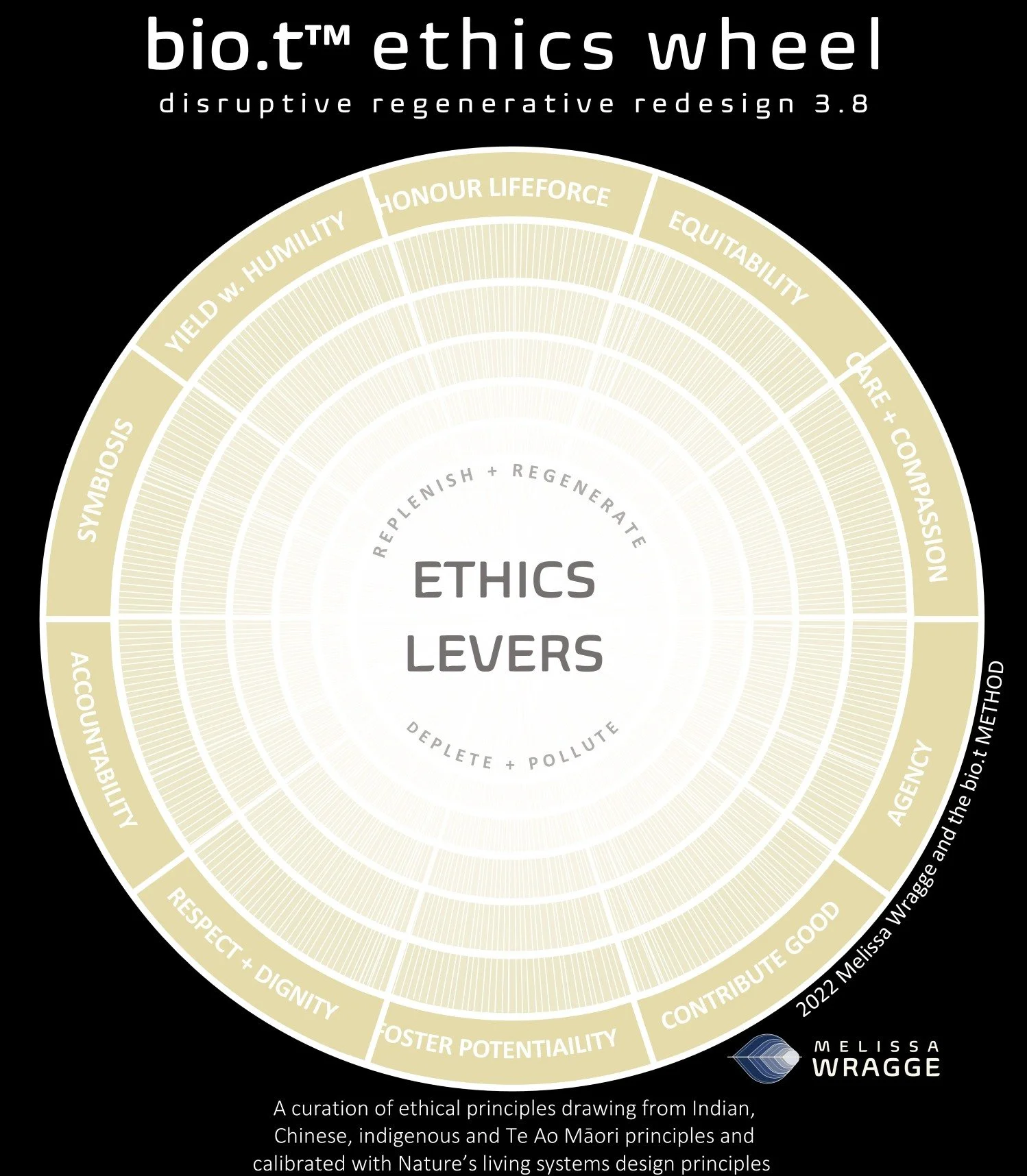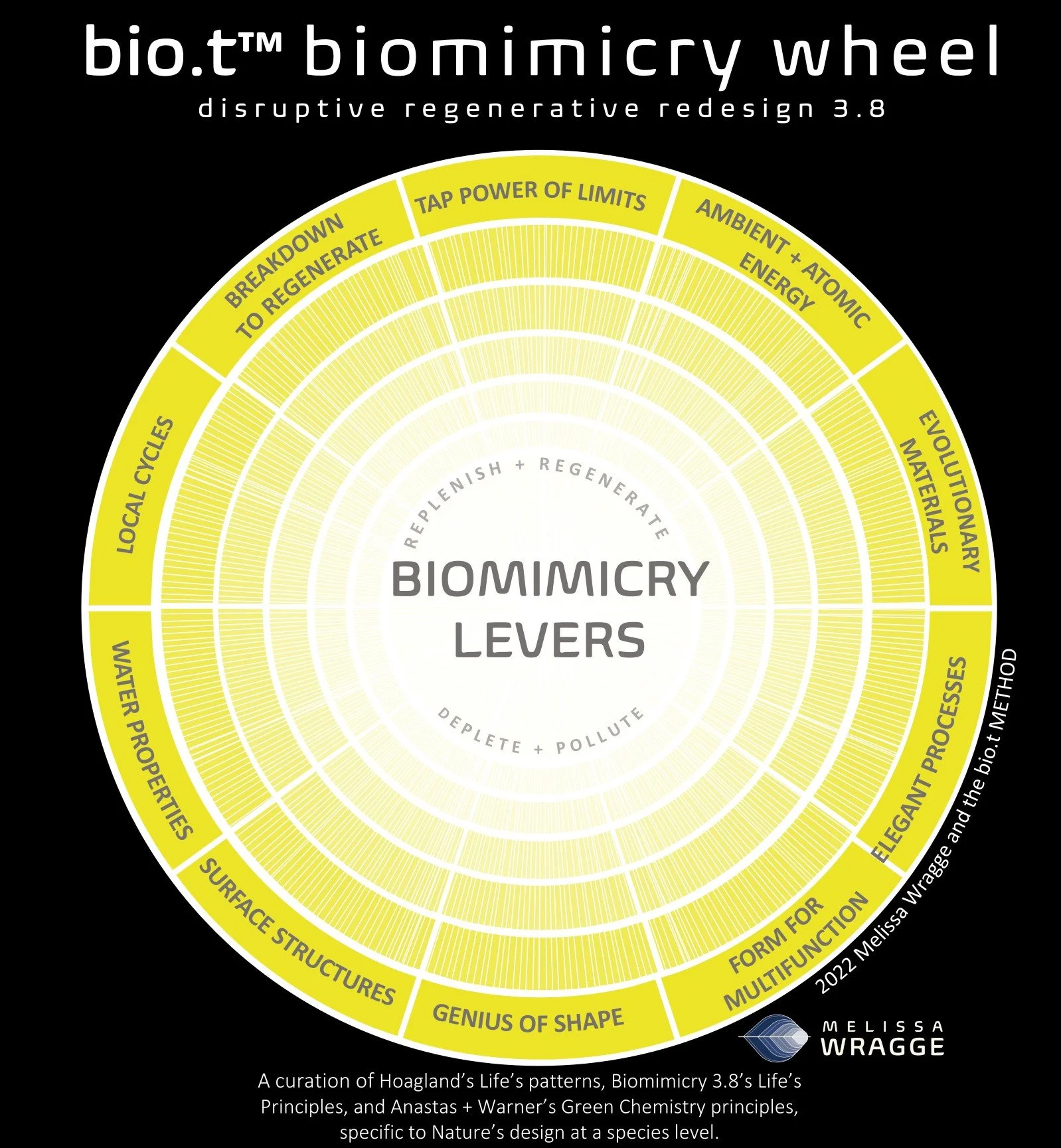
the bio.t™ compass
Our bio.t™ compass curates Nature’s design thinking principles.
living systems, lived experience, life leveraged.
Why? Because these aren’t feel good values. They are value levers that unlock value growth potential. Based on the deep design patterns of Nature’s 3.8 years of evolutionary intelligence. They build your complex adaptive capabilities, and level up your strategic practice. Together, they work like a reorientation compass, based on re/connecting, in relationship. It’s what we call building your BQ™; your biological quotient.
DIAGNOSE. DISCOVER. DESIGN. DEPLOY differently
the blueprinting
business model innovation is all about re/designing how we create, deliver and convert value.
which means, in a disruptive world, we first need to flex our capabilities in how we sense, seize and transform value (called our “dynamic capabilities”).
but there’s a second step. The hardcoding that underpins Nature’s blueprints is based on not one, but four dimensions of value. So unlocking our disruptive potential requires us to play deeper, in relationship. We think of it like a reorientation compass.
1.
F1V :: S1VP
Living Systems
VALUE FLOW | SENSING POTENTIAL
We first need to understand how living systems work.
Why? Because living systems thinking is different than typical systems thinking. It’s functional. Which means it help us more easily find leverage points to best disrupt our market, industry, social system or organization. It gives us way better CONTEXT to inform where to play strategically. And it works as a way better DIAGNOSTIC tool for assessing our disruptive risk and potential.
We still use some of the same techniques, but we go a few steps further forward. We use the critical systems levers that Nature has used over evolution, to not just create functioning systems, but to regenerative and self renew after disruption.
Living system thinking changes our lens on how we look at our ecosystem. We look underneath patterns of change, to how the patterns have been created and locked in place. It requires a shift in our relationship to time (in motion) and the invisible.
This helps us fast track our discovery and design process. And it helps us better transform away from linear systems that trap value, to circular, cyclic systems that keep not just materials, but nutrients, energy, information and power, in flow.
-
These living systems levers are a curation of Nature’s systems design principles from Hoagland’s Life patterns, Allenby & Cooper’s Ecological Systems, Biomimicry 3.8 Life Principles. They are calibrated with Meadow’s levers of systems disruption. alongside Steiner’s biodynamic principles, Mollison’s permaculture principles and regenerative agricultural soil principles.
They reflect the deep patterns of Nature's living systems at a systems level: Nature recycles everything. Everything is a nutrient. Leakage is utilised; entropy is minimised.
"Pollution is nothing but the resources we are not harvesting. We allow them to disperse because we've been ignorant of their value." - Buckminster Fuller
"We triage our actions. Just as nature doesn't use a hammer to correct imbalances, we look at 'tickling the system'; using as little pressure as possible, to yield far greater responses" - Nicole Masters
-
We use systems levers to help us diagnose and design disruptive opportunities. They also help us define our operating model. Used in Step 1, Step 2 and Step 7 of the bio.t Canvas.
-
Whilst we don’t lead with it (because there is so much greenwashing), we do still weave in circularity into systems thinking.
If you’re wondering how to shift from a linear game to a more circular game, we do curate Walter Stahel’s circular economic principles, McDonough & Braungart’s cradle to cradle principles, and Dame Ellen MacArthur’s circular design principles.
We use these circular keys, more tactically than strategically, to design with greater efficiency, when it comes to designing our value propositions and operating model in Step 6 & 7.
-
Systems thinking can get abstract and overwhelming quite quickly. Which means systems mapping runs the risk of going off-track.
If you want a quick rule of thumb when learning systems thinking, be mindful of nouns (like “complexity” or “emergence”) or adjectives (like “dynamic”). These often describe operating conditions but can be harder concepts to apply in practice.
Instead, go for verbs (like “decentralise” or “diversify”). And pay attention to adverbs - how things are done. The genius is in the how. Nature’s design playbook is active not passive.
2.
F2V :: S2VP
Living Ecologies
VALUE FLOURISH | SEIZING POTENTIAL
Secondly we need to understand our ecologies.
Why? Because as global markets price in the costs of Nature’s living world, if we’re only taking action on a climate front, we’re blinkered from the greatest opportunities for disruptive growth, for us, our market and the industry behind it. It’s the second diagnostic tool that gives us CONTEXT and informs us where to play.
Ecology thinking changes our language to the material substance of life. Water. Soil. Nutrient flows. Land. Species’ health. People’s physiological health etc.
Ecology thinking helps us as we step behind the market or social system to better understand industry practices. It helps us more easily see the levers to transform from polluting, toxic or sick, to cleaner, healthier and life-giving. And from stock depleting to stock renewing. It requires a shift in our relationship to time and place.
When used alongside our living system wheel, we can also better see the leverage points to create ripple effects of regenerative change.
-
These ecology levers are a curation of Stockholm Resilience Centre’s planetary boundaries, Kate Raworth’s doughnut economics, Circular Economy principles of finiteness, alongside soil and human health.
Transforming from polluting, toxic or sick, to cleaner, healthier and life-giving. Transforming from depleting to restoring stocks of living systems.
We look at things like water, nutrient flows, biodiversity, soil, land. etc. We also look to the health and wellbeing of people - in community, in relationship, in individual physiological heath.
Nature creates using life friendly chemistry. Nature creates conditions conducive for life.
"In nature's economy the currency is not money, it is life." - Vandana Shiva
"I know it sounds crazy, but every time I have made a decision that is best for the planet, I have made money." - Yvon Chounard, founder Patagonia
-
Understanding ecology help us better SENSE + SENSE-MAKE bio stocks and flow in the lifecycle of our / our industry's products and service. The flow of nutrients, materials, water and energy. We can also abstract this for social and organisational systems and look at the potential in potential.
We use ecology levers, not just to assess our impact, but to reveal untapped biological value potential. They help us design our value chain, value propositions and operating model. Used in Step 2, Step 6 and Step 7.
3.
XV :: S3VP
Living Ethics
VALUE EXCHANGE | SCALE POTENTIAL
Thirdly, we need to understand ethics.
Why? Because Nature’s living systems exist in interconnected webs that are based on relationships. In fact, cooperative symbiotic partnerships are Nature's #1 low-energy 'go-to' strategy. So how we do relationship matters.
We look at ethics not from a HR or compliance perspective, but as a discovery tool to help us re-CONNECT with our stakeholders. It also helps us as a design tool when building our NETWORK potential for demand-led growth and SCALE. It requires a shift in our relationship to self, others and the wider collective.
Ethics thinking changes our leverage points towards symbiosis. And our approach to scale. It helps us transform our business model from depending on unequitable value exchanges to more equitable, dignified relationships. Honoring rights and ‘personhood’. For people, communities, and the 30 million+ other species we live alongside.
-
These ethics levers curate deep patterns and principles that run through ethical principles drawing from Indian, Chinese, indigenous ethics and Te Ao Māori principles.
They have then been calibrated with Nature’s living systems design principles.
"To give preference to a life simply because that being is a member of our species would put us in the same position as racists” - Peter Singer
-
We use ethics levers to help us discover points of greatest tension - “unmet needs” for all our stakeholders and customers (one of the foundational principles of design thinking is that you design off the need not the bright idea).
We also use ethics to help us reveal untapped human value potential in the design of our customer relationship model to lift lifetime value and leverage network effects.
Lastly we use ethics when we’re thinking about NETWORKS and SCALE. Used in Step 3, Step 4 and Step 9
4.
TV :: TVP
Living Ethics
VALUE TRANSFORM | TRANSFORMATION POTENTIAL
Lastly, we need to understand biomimicry.
Why? Because Nature has evolved some deep design patterns to not only survive within constraints and finiteness for the last 3.8B years, but to regenerate from disruption.
We use biomimicry as a design aid as we create our VALUE PROPOSITIONS and internal OPERATIONAL systems. It also works as a DIAGNOSTIC tool to assess our disruptive risk and potential, in looking at our overall business model. It requires a shift in our relationship with materials, form, processes and energy.
Biomimicry radically levels-up our approach to INNOVATION. It helps us unlock the full bio-potential of how Nature designs and leverages tension. We get to TRANSFORM our operations from material and energy waste to unrivalled performance, efficacy, efficiencies and scale.
Yes it’s based on the science of life - but no, you don’t have to be a scientist. We’ve extracted and abstracted Nature’s deep design principles so you can apply them to your business without having to do any of the heavy lifting.
-
These biomimicry levers curate the science of Mahlon Hoagland’s Life’s patterns, Biomimicry 3.8’s Life’s Principles, Paul Anastas and John Warner’s Green Chemistry principles, and Paul Anastas and Julie Zimmerman's Green Engineering principles.
They reflect the deep patterns of functioning living systems at an individual species organism level.
We tap into Nature’s 3.8 billion year old R&D library and tech toolkit. We abstract biological evolutionary strategies of adaptation and we apply them in how we design and innovate.
We pull together common patterns across many species, and we also highlight champion species who have evolved incredible mechanisms that we can use as design stimuli
"Organisms don't think of CO2 as a poison. Plants and organisms that make shells, coral, think of it as a building block." - Janine Benyus
"The more physics we use, the less engineering we need" - Ernst Rutherford
"Work with life centered principles and the universe pitches in to help.” - Buckminster Fuller
“While AI dominates headlines, biology is converging with exponential technologies to unlock unprecedented value. It will revolutionize every market in the next 5-10 years” - Singularity University 2025
We are only at the very beginning of our transformative potential
-
We use biomimicry levers as models to emulate and innovate off, in the design of our value propositions, and our supporting operating model. This is the genius hidden in plain sight.
They give us unparalleled smarts as we innovate for superior performance, efficacy and efficiency.
Used in Step 6 and Step 7
these principles have been curated from Melissa’s deep analysis of 100 years of regenerative living-system research of how Nature designs. See the research.



